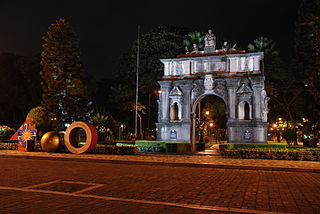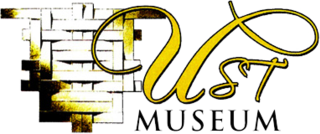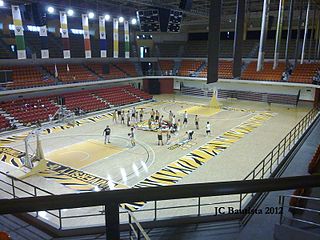Collections
This section is empty.You can help by adding to it.(January 2016) |
The UST Medicine Museum and Art Gallery or simply the UST Medicine Museum is located in the University of Santo Tomas, in Manila, Philippines. Part of the exhibit includes collections in medical instruments, breakthroughs, artifacts, models, paintings, inventions and other tangible cultural heritage.
It is located on the second and fourth floors of the Medicine Building. It serves as a supplementary teaching and learning methodology for students.
Formally called as the Dr. Gabriel History of Medicine and Forensic Medicine Museum.
The present museum was unveiled on June 17, 2006.
This section is empty.You can help by adding to it.(January 2016) |

Syktyvkar is the capital city of the Komi Republic, Russia.

The University of St. Thomas is a private Catholic university in Greater Houston, Texas. Founded in 1947 by Basilian Fathers, it is the only Catholic university in the Archdiocese of Galveston-Houston. Its main campus is in Montrose, Houston; St. Mary's Seminary is a separate campus, and it has an additional campus in Conroe.

The Pontifical and Royal University of Santo Tomas, the Catholic University of the Philippines, or simply the University of Santo Tomas (UST), is a private, Catholic research university in Manila, Philippines. Founded on April 28, 1611, by Miguel de Benavides, Archbishop of Manila, it has the oldest extant university charter in the Philippines and in Asia, and is one of the world's largest Catholic universities in terms of enrollment found on one campus. The university is run by the Order of Preachers. UST is the only university to have been visited by three popes four times: once by Pope Paul VI on November 28, 1970, twice by Pope John Paul II on February 18, 1981, and January 13, 1995, and once by Pope Francis on January 18, 2015. The patron of the university is St. Thomas Aquinas, while St. Catherine of Alexandria is the patroness.

The Arch of the Centuries is a triumphal arch at the Plaza Intramuros of the University of Santo Tomas (UST) in Manila, in the Philippines that stands meters away from the university's Millennium Gate along España Boulevard. Half of the current structure, the side facing the UST Main Building is the ruins of the original Intramuros arch while the side that faces España Boulevard is a replica. The arch was formerly the original entrance to the university when the campus was still in Intramuros during the years from 1680 to 1941. It was declared by the National Museum as a National Cultural Treasure on January 25, 2010.

The University of Santo Tomas Faculty of Medicine and Surgery is the medical school of the University of Santo Tomas, the oldest and largest Catholic university in Manila, Philippines.

The University of Science and Technology (UST) is a group of public universities and research institutions in Seoul, Suwon, Changwon, Ansan, Seongnam and Daejeon, in South Korea. The UST was established in 2003 by the Ministry of Science, ICT and Future Planning as the nation’s graduate school specializing in science and engineering education and research. The UST runs only a graduate school. Creating the new driving force for growth would play a major role in leading national growth in the new century. The South Korean government established the UST to produce professionals in the field of combined technologies, thought of as one of the most important criteria for creating the driving force for South Korea's national growth. Today, UST continues to develop itself into a major research university.

The University of Santo Tomas in Manila, Philippines marks a variety of traditions largely influenced by the Filipino Dominican culture. Many are annual events, such as religious assemblies marking the start and end of the academic year, a "welcome walk" for new students, as well as intercollege sport competitions and talent exhibitions. Christmas is celebrated in a month-long festivities culminated by the UST Paskuhan. Many Roman Catholic feast days are also celebrated.

The University of Santo Tomas is one of the oldest existing universities and holds the oldest extant university charter in the Philippines and in Asia. It was founded on April 28, 1611 by the third Archbishop of Manila, Miguel de Benavides, together with Frs. Domingo de Nieva and Bernardo de Santa Catalina. It was originally conceived as a school to prepare young men for the priesthood. Located Intramuros, it was first called Colegio de Nuestra Señora del Santísimo Rosario and later renamed Colegio de Santo Tomás in memory of Dominican theologian Saint Thomas Aquinas. In 1624, the Colegio was authorized to confer academic degrees in Theology, Philosophy and Arts. On November 20, 1645 Pope Innocent X elevated the College to the rank of a university and in 1680 it was placed under royal patronage.

The University of Santo Tomas Museum of Arts and Sciences is the oldest existing museum in the Philippines. It started as a Gabinete de Fisica, or observation room, of mineral, botanical and biological collections in the 17th century. Under the old Spanish educational law the collections were used as classroom materials, especially in Medicine and Pharmacy.

Ust-Nera is an urban locality and the administrative center of Oymyakonsky District in Yakutia, Russia, located in one of the coldest permanently inhabited regions on Earth, approximately 870 kilometers (540 mi) northeast of Yakutsk, the capital of the republic. As of the 2010 Census, its population was 6,463.

The Main Building of the University of Santo Tomas (UST) in Manila, Philippines functions as the university's administrative center, and home of the Faculty of Civil Law, Faculty of Pharmacy, and the College of Science. The Main Building is also the home of the Museum of Arts and Sciences.
The Pontifical and Royal University of Santo Tomas celebrated its 400th anniversary in 2011. The agenda before the quadricentennial in 2011 included the introduction of new academic programs, improvements in the university's infrastructure, and other projects to raise UST's national and international prominence and promote its role as a social catalyst.

The Quadricentennial Pavilion is a 5,792-seat multi-purpose gymnasium of the University of Santo Tomas (UST) located at the site of the former old Engineering Complex and adjacent football field in front of the Roque Ruaño Building.

Ust-Kubinsky District is an administrative and municipal district (raion), one of the twenty-six in Vologda Oblast, Russia. It is located in the center of the oblast and borders with Vozhegodsky District in the north, Kharovsky District in the northeast, Sokolsky District in the southeast, Vologodsky District in the southwest, and with Kirillovsky District in the west. The area of the district is 2,400 square kilometers (930 sq mi). Its administrative center is the rural locality of Ustye. District's population: 8,094 (2010 Census); 9,350 ; 11,280 (1989 Census). The population of Ustye accounts for 48.7% of the district's population.

The University of Santo Tomas Athletic Field and Open Spaces, located at the University of Santo Tomas in Manila, is a National Cultural Treasure as declared by the National Museum of the Philippines.

The University of Santo Tomas Central Seminary Building currently houses the Santísimo Rosario Parish, the Central Seminary, and the Faculties of Ecclesiastical Studies of the Pontifical and Royal University of Santo Tomas in Manila. The Parish was canonically inaugurated on April 26, 1942 by Michael J. O'Doherty, the Archbishop of Manila. On January 25, 2010, the National Museum of the Philippines formally declared the Central Seminary Building as a National Cultural Treasure.

Ust-Kuyga Airport is an airport serving the urban locality of Ust-Kuyga, Ust-Yansky District, in the Sakha Republic of Russia. It is located near the Arctic Circle.
The University of Santo Tomas, in Manila, Philippines, one of the oldest universities in the Philippines, is constantly featured in popular culture.